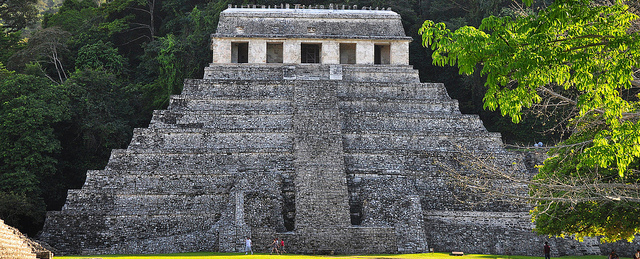

 |

|

|
|
Situated at the eastern edge of the Rio Usumacinta Basin in the foothills of the Sierra Oriental de Chiapas at an elevation of slightly less that 3000 m, Palenque looks out on a low coastal plain extending to the Gulf of Mexico about 130 km. to the north. The climate is warm (median temperature 26 C) and humid (average annual precipitation 2156 mm) with little seasonal variation and showers during the entire year. Surrounded by dense forests dominated by mahogany, cedar and sapodilla trees, frequently shrouded in fog, the ruins are among the most aesthetically impressive in Mesoamerica. Palenque represents the western regional variant of Classic Maya civilization. Although the earliest occupation of the site dates to about 100 BC, it becomes a major population center only at about 600 AD and all construction at the site has ceased by about 800 AD. The ruins now visible are the heavily restored remains of the ceremonial center (Map 2) of a more extensive settlement (Map 3) bordered by agricultural fields. The ceremonial center may be divided into three major areas:
Information obtained from inscriptions on the structures relates their construction to the rulers of Palenque. Pacal assumed power in 603 AD at the age of 12 and ruled for 68 years until his death in 683 AD. In 647 AD he built the Forgotten Temple. located some .5 km south of the Palace. (then somewhat less extensive than its final form). He also constructed the Temple of the Count, as well as underground galleries beneath corbled passages in the Palace. Stucco reliefs of masks in tableros on the west end of the north facade of the Palace and figures with well defined facial features on columns on the north facade celebrate Pacal's ancestry. (Map 4) Pacal's remains, adorned with jade ornaments and face covered with a jade mask were deposited in a stone sarcophagus covered with an elaborately carved stone located in a chamber 1.5 m below the surface of the plaza above which was erected the Pyramid of the Inscriptions The sarcophagus is accessible by a stairway from Temple of the Inscriptions on the top of the pyramid. Chan-Balum, Pacal's eldest son, assumed power in 684 AD upon the death of his father and ruled for 18 years. He was responsible for the completion of the temple atop the Pyramid of the Inscriptions modeled after the Forgotten Temple and the construction of the Group of the Cross temples: the Temple of the Cross, the Temple of the Foliated Cross, and the Temple of the Sun. The panels on the rear interior walls of all these temples depict Chan-Balum and Pacal containing texts purporting to legitimate Chan-Balum's power. Kan-Xul the younger son of Pacal succeeded his older brother in 702 AD at the age of 38 and ruled for 23 years. He remodeled the Palace adding rooms, galleries and courtyards with bas-relief slabs some exhibiting fine detail. Under Kan-Xul's direction the Palace assumed roughly its present form including T-windows (also present in other structures at Palenque and at other sites) whose function is unclear. The T-form also appears in the Ik day glyph which means `wind" and `breath" and might be taken as a metaphor for `life'. Kan-Xul may also been responsible for adding the tower to the Palace. This structure supported by wooden lentils with an interior staircase is thought by some to have functioned as an astronomical observatory, a theory supported by the presence of a venus glyph on a landing. Temple XIV is also attributed to Kan-Xul. This structure, was apparently deliberately placed to block access to the Group of the Cross. Kan-Xul is thought to have been made a prisoner of war and decapitated. Though the occupation of Palenque continues until 799 AD, most of the presently visible ruins were constructed prior to the death of Kan-Xul. |
CAN'T FIND WHAT YOU'RE LOOKING FOR? CLICK HERE!!!